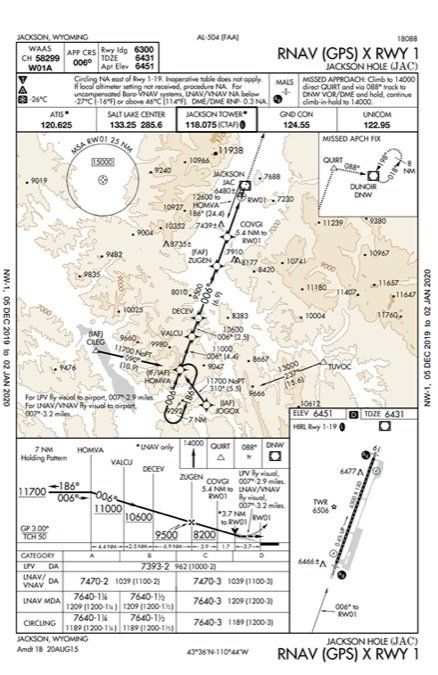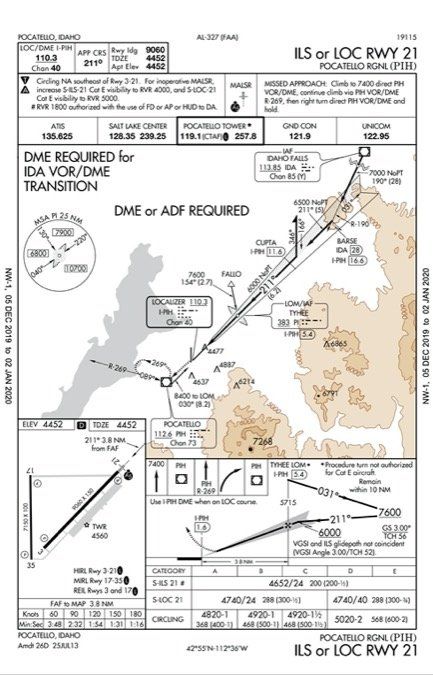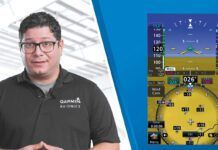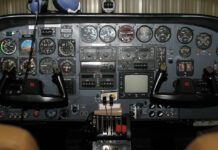Ever wish you flew for a living? If so, think about keeping a smile on while straightening your tie as the client lambastes you that “low IFR” (whatever that is) didn’t stop the last crew. Oh, and you stocked the treat basket with the wrong brand of bottled water. And it’s too warm. Consider yourself fired—but only after you get your hiney in the pilot seat and deliver them to their ski weekend in Jackson Hole.
Now that we’ve set the scene, select a fast aircraft, even a small jet if you’re equipped. If piston, ensure it can reach 15,000 feet. Load real-world weather so you can use your iPad or internet for conditions at each airport. If the weather won’t let you fly this Sim Challenge, adjust accordingly or fly it another day. Good to go? Put yourself on the ramp at Idaho Falls Regional (KIDA).

Your destination is Jackson Hole, WY (KJAC). You filed direct at 15,000. Need an alternate? Plan for that and only load enough fuel to meet the regs. Then set the payload so you’re taxing out at gross. Oh, and assume there’s a NOTAM for Drigg-Reed (KDIJ) of “AWOS OTS.”
You’ll need IFR GPS. If you don’t have that available, keep the departure and destination airports but change the plan accordingly.
Right Seat Occupied
No, it’s not a client sitting there. It’s the Chief Pilot riding along to see you fly this like it was low IFR regardless of the real-world ceilings. It’s early morning, so the tower is closed. Your clearance came back simply “as filed.”
Launch from Runway 21. That’s downwind? Tough. That’s why you get paid to wear the epaulets. Fly the ODP as needed, then head for Jackson Hole. You’re in a hurry, so regardless of the winds, you request the RNAV (GPS) X Rwy 01 and get direct CILEG as soon as you reach 13,000 feet. Your instructions are to cross CILEG at 13,000, cleared for the RNAV X Rwy 01 approach.
Fly the glidepath to circling mins if you must land Runway 19, or the lowest straight-in minimums your GPS allows if you can land Runway 01. Taxi to the ramp and let the passengers get out. Then unload their bags, but don’t put them on the ground. There’s dirt there.
To Pocatello…
The six-year-old’s backpack is missing, and was probably left behind at Pocatello. You didn’t do that flight, but it’s your fault anyway so refuel the tanks and file for Pocatello Regional (KPIH).
Your clearance comes back TETON3.KICNE T331 PIH. Launch and fly as published. As you approach KICNE, you ask ATC for direct PIH, only to have the Chief Pilot jump in and say you actually want to fly the published procedure. The controller suggests you two have some issues to work out and you’re cleared direct IDA to cross at or above 13,000 and cleared for the ILS Runway 21 approach.
Fly the approach, and land straight in unless the tailwind simply makes that impossible. If so, circle to Runway 3 or 35. Taxi to the ramp and stop.
…then Boise
You get the bag, but there’s a message that you need to fetch Aunt Faye from Boise. Add fuel if needed and file for KBOI via V500. You’ll get the KNURL ONE added to that routing as your clearance, with an altitude of 12,000. Launch as best works with the winds, get to KNURL and head on course.

This is a long section, so have some fun once you settle into cruise. Crank up the sim speed to 2x or 4x and try to stay on course and altitude. Then assume at REAPS you get a re-route: After PRESN, it’s V484 KINZE V330 BOI Direct. Fly the lowest MEA you can for your equipment and direction of flight all the way to CANEK. When you reach CANEK, pause the sim and make the winds light out of the southwest, ceilings 300 overcast with miles vis. Fly any approach to a westbound runway at KBOI. If it’s the ILS give yourself a 330 vector to intercept the localizer, maintain 9500 until established, and clearance for the approach.
Land straight in or circle depending on the approach you chose, and taxi to the ramp. When you get there, go inside to discover Aunt Faye actually passed away last week and your passenger is an urn. The plan is to scatter the ashes on the slopes tomorrow. Can you do that from an airplane?
Hint: Exercise some of that captain authority and put your foot down.
Questioning Yourself
Be sure to fly this before going through these questions to see what you might have overlooked.
1. Did you need an alternate? Where?
2. Departing Idaho Falls, which way did you turn after takeoff? How would you enter the hold if you had to use it for climb? How do you hold with your GPS?
3. What about climb gradients on the KIDA departure?
4. When did you turn on course to Jackson Hole? How can the OROCA possibly be lower than the airway MEA?
5. If you’re doing 160 KIAS at the final approach fix into KJAC, the altimeter was standard, the OAT was three degrees C with no wind, what descent rate would you need?
6. Say the visibility was two miles. Would you see the runway at DA? What would you do at that point? What would you do if the visibility was only 1.5 miles?
7. How far off course were you when joining R-192 on the departure from KJAC? When did you turn? What climb rate did you need? Why is there a VCOA for this departure? It’s the same route.
8. Why is DME required for the transition from IDA? What altitude did you fly to BARSE? What was your altitude at the LOM?
9. If you circled for Runway 35 at KPIH, what altitude would you fly?
10. What if you couldn’t accept the Knurl One departing KPIH, how would you depart? How much sooner could you turn on course departing southbound than north? When did you turn to head for KNURL?
11. Which approach would you choose for Boise if the weather was low, and why?




